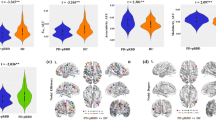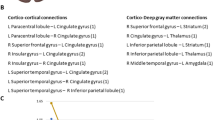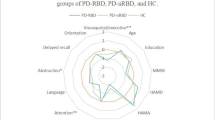Abstract
Epidemiological studies have shown that Parkinson’s disease (PD) patients with probable REM sleep behavior disorder (pRBD) present an increased risk of worse cognitive progression over the disease course. The aim of this study was to investigate, using resting-state functional MRI (RS-fMRI), the functional connectivity (FC) changes associated with the presence of pRBD in a cohort of newly diagnosed, drug-naive and cognitively unimpaired PD patients compared to healthy controls (HC). Fifty-six drug-naïve patients (25 PD-pRBD+ and 31 PD-pRBD−) and 23 HC underwent both RS-fMRI and clinical assessment. Single-subject and group-level independent component analysis was used to analyze intra- and inter-network FC differences within the major large-scale neurocognitive networks, namely the default mode (DMN), frontoparietal (FPN), salience (SN) and executive-control (ECN) networks. Widespread FC changes were found within the most relevant neurocognitive networks in PD patients compared to HC. Moreover, PD-pRBD+ patients showed abnormal intrinsic FC within the DMN, ECN and SN compared to PD-pRBD−. Finally, PD-pRBD+ patients showed functional decoupling between left and right FPN. In the present study, we revealed that FC changes within the most relevant neurocognitive networks are already detectable in early drug-naïve PD patients, even in the absence of clinical overt cognitive impairment. These changes are even more evident in PD patients with RBD, potentially leading to profound impairment in cognitive processing and cognitive/behavioral integration, as well as to fronto-striatal maladaptive compensatory mechanisms.

Similar content being viewed by others
References
Altena E, Micoulaud-Franchi JA, Geoffroy PA et al (2016) The bidirectional relation between emotional reactivity and sleep: from disruption to recovery. Behav Neurosci 130:336–350. https://doi.org/10.1037/BNE0000128
Amboni M, Tessitore A, Esposito F et al (2015) Resting-state functional connectivity associated with mild cognitive impairment in Parkinson’s disease. J Neurol 262:425–434. https://doi.org/10.1007/S00415-014-7591-5
Byun JI, Kim HW, Kang H et al (2020) Altered resting-state thalamo-occipital functional connectivity is associated with cognition in isolated rapid eye movement sleep behavior disorder. Sleep Med 69:198–203. https://doi.org/10.1016/J.SLEEP.2020.01.010
Campabadal A, Abos A, Segura B et al (2020) Disruption of posterior brain functional connectivity and its relation to cognitive impairment in idiopathic REM sleep behavior disorder. Neuroimage Clin. https://doi.org/10.1016/J.NICL.2019.102138
Campabadal A, Segura B, Junque C, Iranzo A (2021) Structural and functional magnetic resonance imaging in isolated REM sleep behavior disorder: a systematic review of studies using neuroimaging software. Sleep Med Rev. https://doi.org/10.1016/J.SMRV.2021.101495
Chahine LM, Xie SX, Simuni T et al (2016) Longitudinal changes in cognition in early Parkinson’s disease patients with REM sleep behavior disorder. Parkinsonism Relat Disord 27:102–106. https://doi.org/10.1016/J.PARKRELDIS.2016.03.006
Christopher L, Koshimori Y, Lang AE et al (2014) Uncovering the role of the insula in non-motor symptoms of Parkinson’s disease. Brain 137:2143–2154. https://doi.org/10.1093/BRAIN/AWU084
De Micco R, Agosta F, Basaia S et al (2021) Functional connectomics and disease progression in drug-naïve Parkinson’s disease patients. Mov Disord 36:1603–1616. https://doi.org/10.1002/mds.28541
Disbrow EA, Carmichael O, He J et al (2014) Resting state functional connectivity is associated with cognitive dysfunction in non-demented people with Parkinson’s disease. J Parkinsons Dis 4:453–465. https://doi.org/10.3233/JPD-130341
Dreher JC, Berman KF (2002) Fractionating the neural substrate of cognitive control processes. Proc Natl Acad Sci USA 99:14595–14600. https://doi.org/10.1073/PNAS.222193299
Ellmore TM, Castriotta RJ, Hendley KL et al (2013) Altered nigrostriatal and nigrocortical functional connectivity in rapid eye movement sleep behavior disorder. Sleep 36:1885–1892. https://doi.org/10.5665/SLEEP.3222
Fereshtehnejad SM, Zeighami Y, Dagher A, Postuma RB (2017) Clinical criteria for subtyping Parkinson’s disease: biomarkers and longitudinal progression. Brain 140:1959–1976. https://doi.org/10.1093/BRAIN/AWX118
Filippi M, Elisabetta S, Piramide N, Agosta F (2018) Functional MRI in idiopathic Parkinson’s disease. Int Rev Neurobiol 141:439–467. https://doi.org/10.1016/BS.IRN.2018.08.005
Jia X, Fan W, Wang Z et al (2022) Progressive prefrontal cortex dysfunction in Parkinson’s disease with probable REM sleep behavior disorder: a 3-year longitudinal study. Front Aging Neurosci. https://doi.org/10.3389/FNAGI.2021.750767
Jiang J, Liu T, Crawford JD et al (2020) Stronger bilateral functional connectivity of the frontoparietal control network in near-centenarians and centenarians without dementia. Neuroimage. https://doi.org/10.1016/J.NEUROIMAGE.2020.116855
Leech R, Kamourieh S, Beckmann CF, Sharp DJ (2011) Fractionating the default mode network: distinct contributions of the ventral and dorsal posterior cingulate cortex to cognitive control. J Neurosci 31:3217–3224. https://doi.org/10.1523/JNEUROSCI.5626-10.2011
Leh SE, Petrides M, Strafella AP (2010) The neural circuitry of executive functions in healthy subjects and Parkinson’s disease. Neuropsychopharmacology 35:70–85. https://doi.org/10.1038/NPP.2009.88
Lehericy S, Vaillancourt DE, Seppi K et al (2017) The role of high-field magnetic resonance imaging in parkinsonian disorders: pushing the boundaries forward. Mov Disord 32:510–525. https://doi.org/10.1002/mds.26968
Li D, Huang P, Zang Y et al (2017) Abnormal baseline brain activity in Parkinson’s disease with and without REM sleep behavior disorder: a resting-state functional MRI study. J Magn Reson Imaging 46:697–703. https://doi.org/10.1002/JMRI.25571
Niendam TA, Laird AR, Ray KL et al (2012) Meta-analytic evidence for a superordinate cognitive control network subserving diverse executive functions. Cogn Affect Behav Neurosci 12:241–268. https://doi.org/10.3758/S13415-011-0083-5
Oltra J, Campabadal A, Segura B et al (2021) Disrupted functional connectivity in PD with probable RBD and its cognitive correlates. Sci Rep. https://doi.org/10.1038/S41598-021-03751-5
Postuma RB, Bertrand JA, Montplaisir J et al (2012) Rapid eye movement sleep behavior disorder and risk of dementia in Parkinson’s disease: a prospective study. Mov Disord 27:720–726. https://doi.org/10.1002/MDS.24939
Putcha D, Ross RS, Cronin-Golomb A et al (2016) Salience and default mode network coupling predicts cognition in aging and Parkinson’s disease. J Int Neuropsychol Soc 22:205–215. https://doi.org/10.1017/S1355617715000892
Ruppert MC, Greuel A, Freigang J et al (2021) The default mode network and cognition in Parkinson’s disease: a multimodal resting-state network approach. Hum Brain Mapp 42:2623. https://doi.org/10.1002/HBM.25393
Schenck CH, Montplaisir JY, Frauscher B et al (2013) Rapid eye movement sleep behavior disorder: devising controlled active treatment studies for symptomatic and neuroprotective therapy—a consensus statement from the International Rapid Eye Movement Sleep Behavior Disorder Study Group. Sleep Med 14:795–806. https://doi.org/10.1016/J.SLEEP.2013.02.016
Tahmasian M, Eickhoff SB, Giehl K et al (2017) Resting-state functional reorganization in Parkinson’s disease: an activation likelihood estimation meta-analysis. Cortex 92:119–138. https://doi.org/10.1016/J.CORTEX.2017.03.016
Tessitore A, Cirillo M, de Micco R (2019) Functional connectivity signatures of Parkinson’s disease. J Parkinsons Dis 9:637–652. https://doi.org/10.3233/JPD-191592
van Eimeren T, Monchi O, Ballanger B, Strafella AP (2009) Dysfunction of the default mode network in Parkinson disease: a functional magnetic resonance imaging study. Arch Neurol 66:877–883. https://doi.org/10.1001/ARCHNEUROL.2009.97
Vogt BA, Laureys S (2005) Posterior cingulate, precuneal and retrosplenial cortices: cytology and components of the neural network correlates of consciousness. Prog Brain Res 150:205–217. https://doi.org/10.1016/S0079-6123(05)50015-3
Wakasugi N, Togo H, Mukai Y et al (2021) Prefrontal network dysfunctions in rapid eye movement sleep behavior disorder. Parkinsonism Relat Disord 85:72–77. https://doi.org/10.1016/J.PARKRELDIS.2021.03.005
Zanto TP, Gazzaley A (2013) Fronto-parietal network: flexible hub of cognitive control. Trends Cogn Sci 17:602–603. https://doi.org/10.1016/J.TICS.2013.10.001
Zhang J, Xu CY, Liu J (2017) Meta-analysis on the prevalence of REM sleep behavior disorder symptoms in Parkinson’s disease. BMC Neurol. https://doi.org/10.1186/S12883-017-0795-4
Funding
No funding was received for conducting this study.
Author information
Authors and Affiliations
Contributions
Conceptualization: RDM, GT, AT; methodology: FDN, MS, FE; formal analysis and investigation: RDM, NP, AR, MC, MS; writing—original draft preparation: RDM, NP; writing—review and editing: RDM, NP, FDN, MS, AR, MC, MS, FE, AT; supervision: AT.
Corresponding author
Ethics declarations
Conflict of interest
The authors have no relevant financial or non-financial interests to disclose.
Ethical statement
All subjects gave full written consent to be included in experimentation. The study was approved by the local Ethical Committee and has, therefore, been performed in accordance with the ethical standards laid down in the 1964 Declaration of Helsinki and its later amendments.
Data availability
The data that support the findings of this study are available from the corresponding author upon reasonable request.
Additional information
Publisher's Note
Springer Nature remains neutral with regard to jurisdictional claims in published maps and institutional affiliations.
Supplementary Information
Below is the link to the electronic supplementary material.
Rights and permissions
Springer Nature or its licensor (e.g. a society or other partner) holds exclusive rights to this article under a publishing agreement with the author(s) or other rightsholder(s); author self-archiving of the accepted manuscript version of this article is solely governed by the terms of such publishing agreement and applicable law.
About this article
Cite this article
De Micco, R., Piramide, N., Di Nardo, F. et al. Resting-state network connectivity changes in drug-naive Parkinson’s disease patients with probable REM sleep behavior disorder. J Neural Transm 130, 43–51 (2023). https://doi.org/10.1007/s00702-022-02565-7
Received:
Accepted:
Published:
Issue Date:
DOI: https://doi.org/10.1007/s00702-022-02565-7




